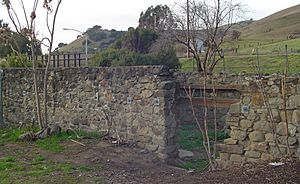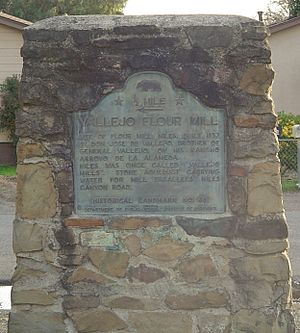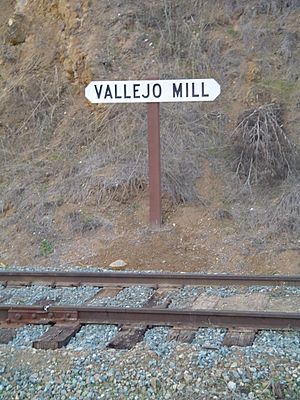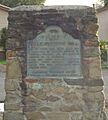Vallejo Flour Mill facts for kids
Quick facts for kids Vallejo Flour Mill |
|
|---|---|
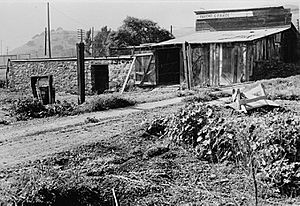
1856 Vallejo Flour Mill foundation (looking northwest, August 1940)
|
|
| Location | Vallejo Flour Mill Historic Park, Niles Canyon Rd and Mission Blvd, Fremont, California |
| Built | 1856 |
| Architect | José de Jesús Vallejo |
| Reference no. | 46 |
| Lua error in Module:Location_map at line 420: attempt to index field 'wikibase' (a nil value). | |
The Vallejo Flour Mill was an important mill built a long time ago in what is now Fremont, California. The first mill was built in 1853 by José de Jesús Vallejo. He was the older brother of a famous general, Mariano Guadalupe Vallejo. The mill was on his large ranch, called Rancho Arroyo de la Alameda.
The mill was located at the entrance of Niles Canyon. This area was once known as Alameda Cañon. Alameda Creek flowed through this canyon. A second, bigger mill was built in 1856. You can still see the stone foundation of this second mill today.
The old ruins of the Vallejo Flour Mill are in Vallejo Mill Historical Park. This park is at the corner of Niles Canyon Road (State Route 84) and Mission Boulevard (State Route 238). In 1932, the mill ruins were named a California Historical Landmark (#46). This means it's a very important historical place in California.
We know what the 1856 mill looked like from a painting. Carmelita Vallejo, the daughter of J & J Vallejo, painted it. She was studying at the San Jose Notre Dame Academy. Her painting showed several buildings around a three-story mill. It had a huge wooden wheel on its north side. This wheel was 30 feet tall and 8 feet wide. It was an "overshot" design, meaning water flowed over the top of it to make it spin. The millstone inside was 4 feet across. The mill cost $5,000 to build. It could make 150 barrels of flour every day!
Contents
How the Railroad Changed Vallejo Mill
Building the First Transcontinental Railroad
In the mid-1860s, a company called Western Pacific started building a railroad. This railroad was part of the first transcontinental railroad. It was meant to connect the East and West coasts of the United States. Western Pacific built about 20 miles (32 km) of track. This track went north from San Jose towards Sacramento.
The railroad line went right past the Vallejo Flour Mills. It entered Alameda Cañon, which is now Niles Canyon. The Western Pacific company hired 500 Chinese workers. These workers built the rail line through the tough canyon. They made the ground level and built bridges. Four big wooden bridges were needed to cross Alameda Creek and Arroyo de la Laguna Creek. The workers also built stone walls and culverts. In October 1866, work stopped because of money problems.
Railroad Continues and a New Town Appears
In June 1869, the Central Pacific Railroad took over the project. They also used Chinese workers to finish the line. Central Pacific also built a new line. This line went from the canyon's entrance northwest to Oakland.
An aqueduct carried water to the Vallejo Flour Mills. It ran next to the current Niles Canyon Road. When the railroad construction started again in 1869, Central Pacific rebuilt this aqueduct with stone. Even more importantly, the railroad built a special spot called the Vallejo Mills Junction. This junction was west of the mills. It connected the new 1869 transcontinental line with the older 1866 San Jose line.
That same year, José de Jesús Vallejo's son, Plutarco Vallejo, planned a new neighborhood. He worked with a surveyor named Luis Castro. They laid out 23 lots along Vallejo Street, south of the mills. This plan was recorded on November 3, 1869. The new area was called Vallejo Mills. It was also known as Vallejo Mill or Vallejo's Mill.
Vallejo Mills Becomes Niles
The new settlement was at the meeting point of two main train lines. One line went northwest to Oakland. The other went south to San Jose. After the First transcontinental railroad was finished, Central Pacific changed the name of the Vallejo Mill station. By December 1869, it was called Niles. This name honored their railroad lawyer and stockholder, Addison Niles. He later became a judge.
In 1870, Central Pacific built a train station at Niles junction. It had a restaurant and a saloon for travelers. After this, the Vallejo Mills settlement became known as Niles. Newspapers started using "Niles, Cal" by the mid-1870s. In 1956, Niles became a part of the city of Fremont.
A local resident, Mrs. Snyder, wrote about this in 1904:
- The people of Vallejo Mills in 1857 received their mail by way of Centreville until after the railroad was built.
- Then the name of the place changed to Niles and an express office was established...
- After... two years it was moved to the depot. It was not until 1873 that Niles had a Post-office, it opening in November of that year.
Similarly, Alameda Cañon also became known as Niles Canyon. This happened after Central Pacific renamed the Vallejo Mill station Niles in 1869.
Images for kids


